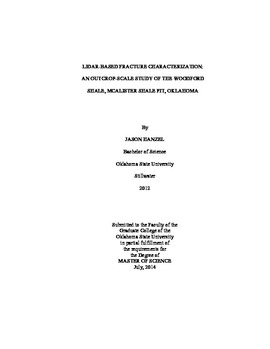| dc.contributor.advisor | Jaiswal, Priyank | |
| dc.contributor.author | Hanzel, Jason | |
| dc.date.accessioned | 2015-06-17T20:06:10Z | |
| dc.date.available | 2015-06-17T20:06:10Z | |
| dc.date.issued | 2014-07-01 | |
| dc.identifier.uri | https://hdl.handle.net/11244/14869 | |
| dc.description.abstract | The use of lidar (light detection and ranging), a remote sensing tool based on principles of laser optometry, in mapping complex, multi-scale fracture networks had not been rigorously tested prior to this study despite its foreseeable utility in interpreting rock fabric with imprints of complex tectonic evolution. This thesis demonstrates lidar-based characterization of the Woodford Shale where intense fracturing could be due to both tectonism and mineralogy. The study area is the McAlister Shale Pit in south-central Oklahoma where both the upper and middle sections of the Woodford Shale are exposed and can be lidar-mapped. Lidar results are validated using hand-measured strike and dips of fracture planes, thin sections and mineral chemistry of selected samples using X-ray diffraction (XRD). Complexity of the fracture patterns as well as inaccessibility of multiple locations within the shale pit makes hand-measurement prone to errors and biases; lidar provides an opportunity for less biased and more efficient field mapping.Fracture mapping with lidar is a multi-step process. The lidar data are converted from point clouds into a mesh through triangulation. User-defined parameters such as size and orientation of the individual triangular elements are then used to group similar elements into surfaces. The strike and dip attribute of the simulated surfaces are visualized in an equal area lower hemisphere projection stereonet. Three fracture sets were identified in the upper and middle sections with common orientation but substantially different spatial density. Measured surface attributes and spatial density relations from lidar were validated using their hand-measured counterparts. Thin section analysis suggests that high fracture density in the upper Woodford measured by both the lidar and the hand-measured data could be due to high quartz. A significant finding of this study is the reciprocal relation between lidar intensity and gamma-ray (GR), which is generally used to infer outcrop mineralogy. XRD analysis of representative samples along the common profiles show that both GR and lidar intensity were influenced by the same minerals in essentially opposite ways. Results strongly suggest that the lidar cannot only remotely map the geomorphology, but also the relative mineralogical variations to the first order of approximation. | |
| dc.format | application/pdf | |
| dc.language | en_US | |
| dc.publisher | Oklahoma State University | |
| dc.rights | Copyright is held by the author who has granted the Oklahoma State University Library the non-exclusive right to share this material in its institutional repository. Contact Digital Library Services at lib-dls@okstate.edu or 405-744-9161 for the permission policy on the use, reproduction or distribution of this material. | |
| dc.title | Lidar-based Fracture Characterization: an Outcrop-scale Study of the Woodford Shale, Mcalister Shale Pit, Oklahoma | |
| dc.type | text | |
| dc.contributor.committeeMember | Byrnes, Jeffrey M. | |
| dc.contributor.committeeMember | Puckette, Jim | |
| dc.contributor.committeeMember | Abdel Salam, Mohamed | |
| osu.filename | Hanzel_okstate_0664M_13555.pdf | |
| osu.accesstype | Open Access | |
| dc.description.department | Geology | |
| dc.type.genre | Thesis | |
| dc.subject.keywords | fractures | |
| dc.subject.keywords | lidar | |
| dc.subject.keywords | mcalister shale pit | |
| dc.subject.keywords | riscan pro | |
| dc.subject.keywords | split-fx | |
| dc.subject.keywords | woodford shale | |
